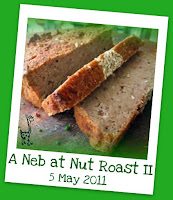I wouldn't say we were huge miso lovers at this abode so I'm not sure why one of the first recipes bookmarked in Appetite for Reduction was a fairly heavily based miso one. I have thought long and hard about this and still have not come up with a satisfactory answer. Miso seems to be one of those flavours that I have grown to like rather than something that you try and can't get enough of from the first bite.
There were quite a few ingredient substitutions made which was mainly to do with using up vegetables that were on hand as well as the addition of fried shallots as a garnish. I loved the combination of fried shallots and sesame seeds garnish in this recipe I have previously made from Veganomicon and thought it would work well here too.
Surprisingly this stir-fry was devoured and enjoyed by all of us. Perhaps we are all coming around to miso.
Miso Udon Stir-Fry with Greens and Beans (Adapted from Appetite for Reduction)
270g packet dried udon noodles
1/3 cup white miso
1/2 cup hot water
1 tablespoon peanut oil1 stalk broccoli, chopped into small florets
12 green beans, chopped into bite-sized pieces
6 cloves garlic, sliced thinly
4 spring onions, chopped
4 brussel sprouts, cut in half and then shredded
2 small carrots, julienned
1 x 425g tin adzuki beans, drained and rinsed
1 tablespoon toasted sesame seeds, for garnish
1 tablespoon fried shallots, for garnish
Sriracha hot sauce, for garnish
Bring a pot of water to the boil and cook the noodles according to the packet directions. Use 1/2 cup of the noodle water to mix with the miso in a small water. When the noodles are ready, drain and then rinse well in cold water to stop the noodles from cooking further.
Heat half of the oil in a wok. When the oil is smoking, stir-fry the broccoli and green beans for a couple of minutes, then remove from the wok.
Add the rest of the oil to wok. Stir-fry the garlic, spring onions, brussel sprout and carrots for a couple of minutes then stir through the adzuki beans. Add the udon noodles and miso-water mixture, return the broccoli and green beans to the wok and stir thoroughly until combined. Turn the heat to low.
Serve topped with toasted sesame seeds, fried shallots and sriracha sauce.
































